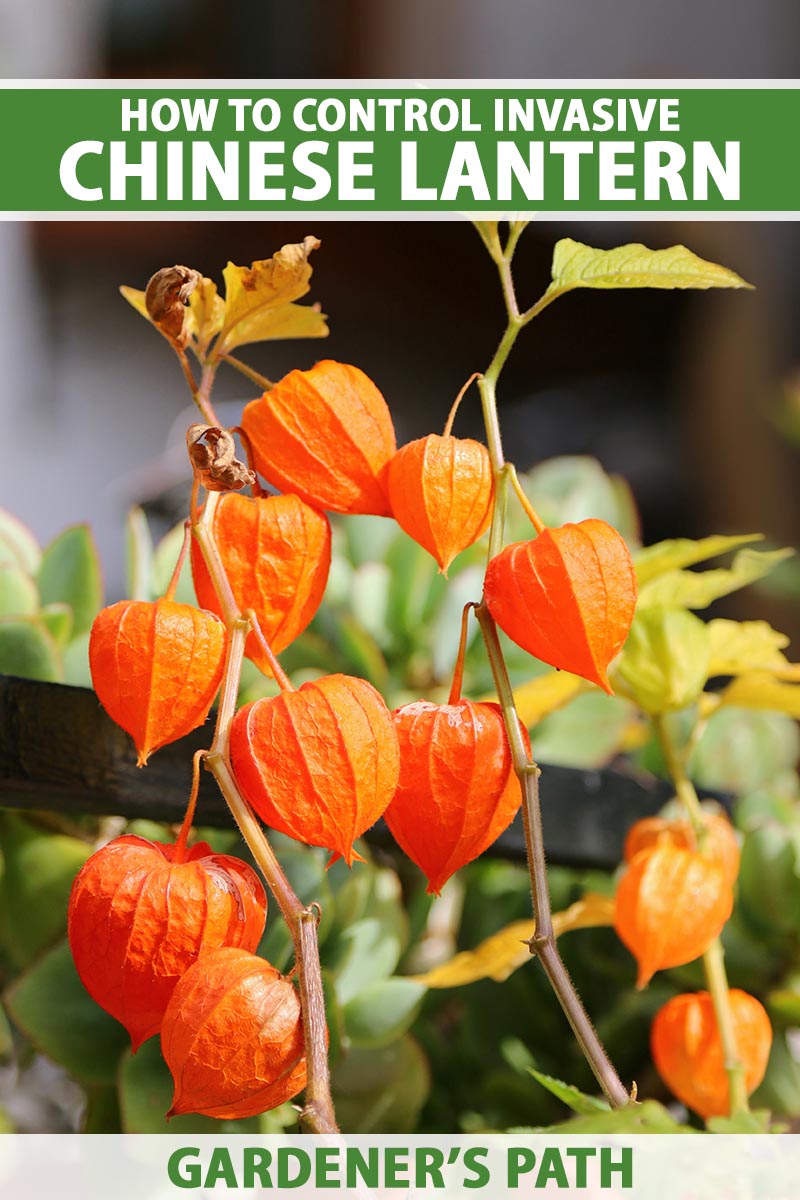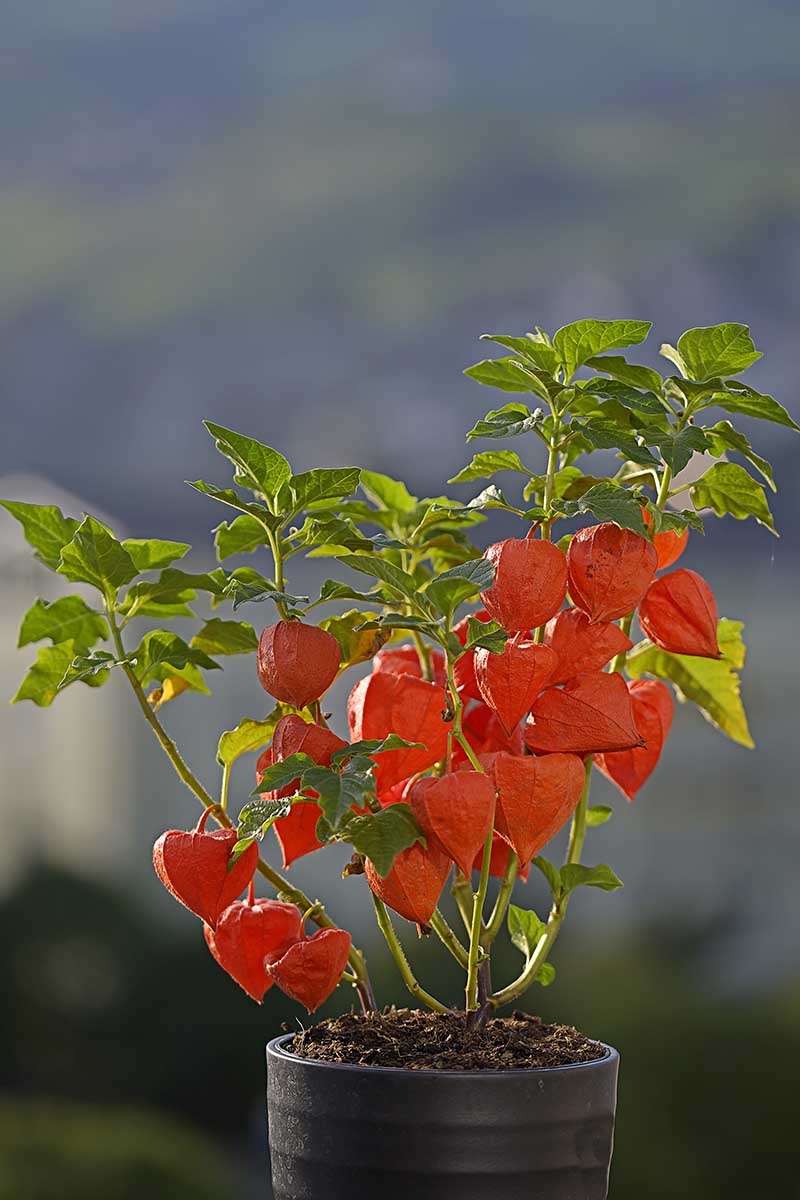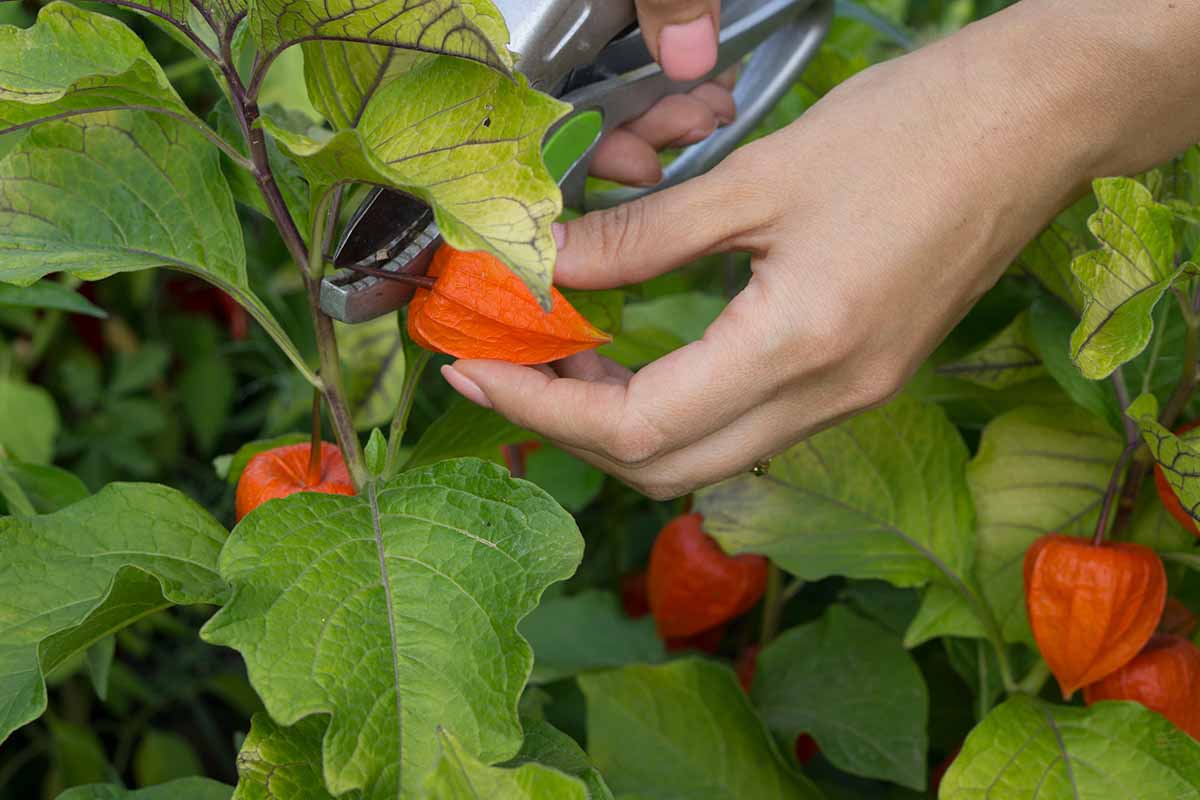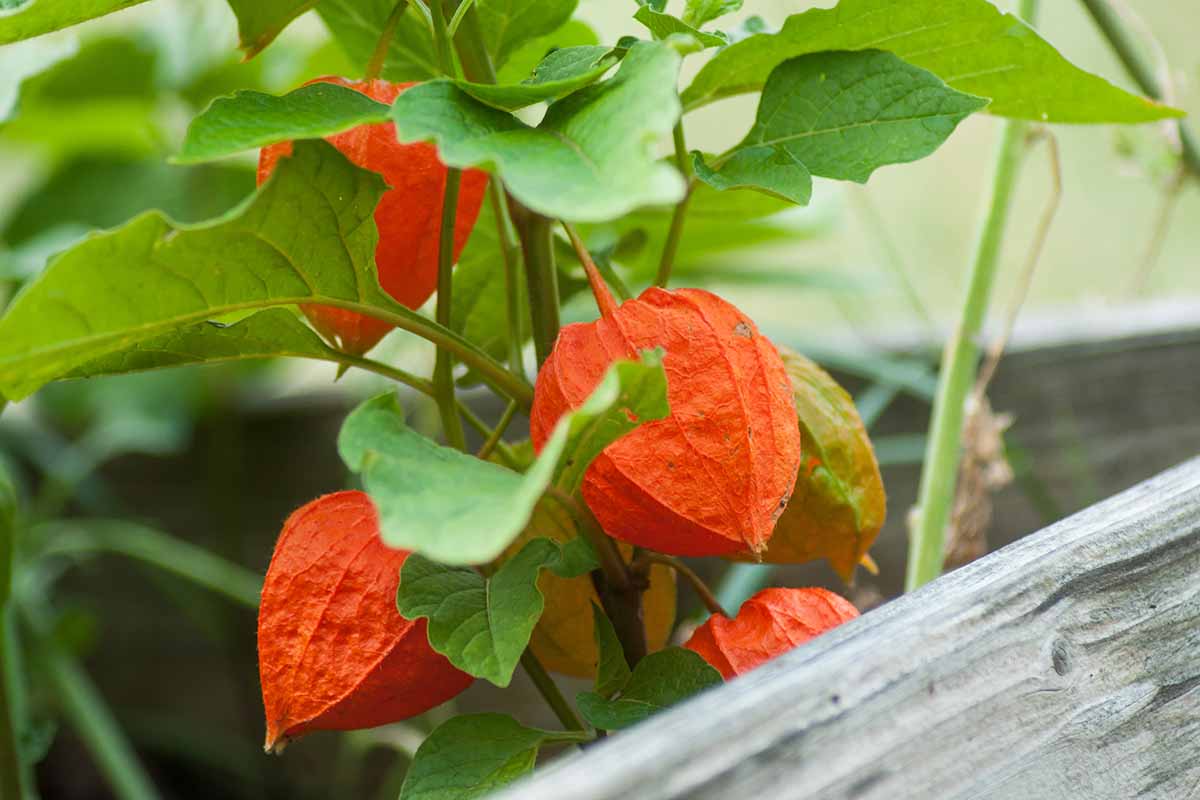Suited to cultivation in USDA Hardiness Zones 3 to 9, these non-native perennials thrive in organically-rich soil and full sun to part shade. We link to vendors to help you find relevant products. If you buy from one of our links, we may earn a commission. Please note that all parts of this plant are toxic, with one exception. Each pod contains a fruit. When the fruit is FULLY ripe, it is considered edible. At all other times, it is toxic, so beware. Our guide to growing Chinese lanterns has all you need to know to grow these plants. This article discusses five remediation methods for unwanted Chinese lanterns and five preventative measures to curb potentially invasive growth and enjoy them in moderation. Here’s what we’ll cover: Let’s begin.
Remediation Measures
It’s upsetting when a species we like takes over the garden, and we find ourselves doing battle instead of enjoying it. Here are some ways to tackle out-of-control Chinese lanterns:
Dig It Up
Use a long-handled shovel to uproot and dispose of unwanted plants. Resist the temptation to pull them up by hand, because if you don’t get all of the roots, the foliage will soon reappear as if you did nothing. You can dig plants up at any time. If you can identify them by their alternating medium green leaves, great. Otherwise, wait until you see a familiar flower or pod, so you don’t accidentally unearth something you’d prefer to keep. When digging, push the full length of the shovel blade into the soil around the plants to unearth them. If they don’t release with a gentle lift, dig deeper. Try not to break the roots, or the remaining bits will grow again. Discard plant debris in the trash to avoid reestablishing the species elsewhere. Then, hoe the soil to loosen any remaining roots and discard them. An alternative is to rent a tiller to churn up the roots for removal. Till before the pods appear to avoid seed dispersal. At this point, you can plant something in its place as desired, or sow a cover crop if you intend to leave the land fallow for a time.
Hire a Goat
Did you know that you can hire goats to come to your property to eat invasive weeds? A few years ago, while reading my hometown newsletter, I learned that goats would soon arrive to clear poison ivy and other undesirable growth from several wooded parks in the area. Called “goatscaping,” the practice is suited to large-scale eradication projects. Per Kendra Waldenberger of the University of Minnesota Agricultural Extension, benefits include the following:
Topsoil is virtually undisturbed.Hooves blend goat droppings into the soil for fertilizer.Goats’ digestive enzymes render eaten and excreted seeds non-viable.Weeds are less vigorous over time when they are “stomped on” by goats.
Now, I grant you that not all of us have a behemoth Chinese lantern invasion on our hands, but even if you have less than an acre to clear, you may find it cheaper and easier, entertaining even, to use herbivores rather than herbicides. Visit HireGoats.com to peruse their directory and look up goat rental companies by state.
Mow
If your Chinese lanterns have jumped garden borders and are popping up in the lawn, you can mow them down right along with the grass. With regular mowing, plants will fail to produce leaves for photosynthesis, depriving the roots of nourishment. They will also never flower or set seed. Mow vigilantly, aerate, and seed the lawn to help crowd out the unwanted nuisances.
Solarize
An additional step you can take to rid your yard of invasives is solarization. It’s a process that uses the summer sun’s heat to cook the soil and kill the life within it. Here’s how to solarize soil, per the Texas A&M AgriLife Extension:
Summer is the best time to make the most of the sun’s intense rays.Remove all plants and debris – digging plants out as described above is the best preparation because deep roots may not respond to solarization.Wet the soil thoroughly.Spread clear plastic painter’s sheeting over the soil.Bury the edges of the plastic in the soil for a snug fit.Anchor the plastic with rocks or bricks.Leave the plastic in place for about four weeks.
Solarization kills plants, pests, and soil microbes. To replace the beneficial organisms that lived in the soil before completing this process, amend generously with organically-rich compost before future planting. Note that while it may be tempting to begin the solarization process in the spring when plants are tiny sprouts, it’s best to wait until summer. Spring sunshine is not bright enough, and the typical rain and winds of the season are likely to loosen and tear the thin plastic sheeting.
Treat with an Herbicide
There are chemical and organic herbicides available that you may wish to use. Products containing glyphosate may be effective against Chinese lantern. However, I caution you: While you’ll read that glyphosate is only “mildly toxic,” this synthetic compound can cause eye, skin, nose, and throat irritation in people and gastrointestinal upset in pets. In addition, there are other ingredients in glyphosate formulas listed as “inert” that may be toxic and harmful to people, pets, and the environment.
Proactive Prevention
Containing plants to prevent them from becoming invasive is easily accomplished with the following: This one from Southland Organics contains clove bud oil, mint oil, and soap ingredients. Torched Weed Killer It offers a natural alternative to glyphosate. Like glyphosate, it is a “post-emergent” treatment to apply to growing weeds, as opposed to a “pre-emergent” one that is applied to the soil before they sprout. It is also similar in that it is both “systemic” and “non-selective.” A systemic herbicide kills the visible foliage and the roots beneath the soil. A non-selective product doesn’t distinguish between a weed and a desirable plant, and destroys both. Torched Weed Killer from Southland Organics is available from Arbico Organics in one- and two-and-a-half-gallon bottles. I am unaware of a formulation, either chemical or natural, specifically intended for Chinese lantern eradication. If you choose this route, remember to use herbicides per package instructions. Even organic ones, like those that contain horticultural-strength acetic acid (vinegar) and essential oils, may be toxic at high levels. Handle all products with care and keep them away from children and pets. Now that we’ve discussed methods to eradicate unwanted plants, let’s explore ways to enjoy Chinese lanterns with a reduced risk of invasiveness.
Container Garden
Container gardening offers an excellent way to control plants by restricting roots that are eager to roam. Choose a vessel with good drainage that can support growth of up to 30 inches tall and 12 to 24 inches wide. Monitor water needs, especially in hot weather, as containers dry out quicker than ground soil. Remove the pods before they open to prevent seed drop.
Divide
One way to slow spreading is to divide or thin plants by cutting through the roots and removing some of them to transplant or discard. Dividing reduces quantity, improves airflow, and inhibits pest infestations and fungal diseases. We usually divide and transplant perennials in the spring, so they have the entire growing season to acclimate to their new locations. However, you can also divide Chinese lantern in the summer or fall, provided you don’t accidentally disperse the seeds. To prevent spread, we’ll discard the divisions rather than transplanting them. Here’s how:
Select a few clusters of stems to remove.Use a hand shovel or hori-hori knife to dig around and under each.Go as deep as you can and get as much of the rootstock as possible.Lift the clusters of stems out of the ground, brush the soil off, and discard them.
Dividing annually helps curb invasiveness. And when you also prevent seed drop, you may be able to achieve a manageable garden.
Harvest Pods
Harvesting the pods for autumn floral arrangements can reduce self-sowing to zero. Snip individual pods or entire pod-laden stems to dry for inclusion in your favorite everlasting creations. Remember that this is only half the battle – healthy roots underground guarantee a return next year.
Isolate the Growing Area
To grow a dedicated patch that won’t spread to the neighbors’ yards, choose a location bounded by hardscaping like brick, concrete, or stone. If you have a foundation garden with a building on one side and a sidewalk on the other, the enclosed garden space may efficiently curb root sprawl. You’ll still need to be vigilant about pod removal to prevent seeds from scattering.
Sink a Pot into Garden Soil
If you choose to grow in a pot, you can consider burying the pot to its rim in the garden for bright orange pops of color among your late-season asters and chrysanthemums. This is similar to what you might do to control the spread of mint. Prevent self-sowing by snipping off the pods before they open, and lift the pot out before the first frost, so it doesn’t crack. Check the bottom of the pot to make sure no roots have grown through into the soil. If they have, dig them out and discard them.
Sow in a Lined Raised Bed
Cultivation in a raised bed is an excellent way to inhibit spreading, especially when you line the bottom with landscaping fabric. Staple the fabric to the wood sides of the raised bed so there are no gaps for the roots to creep through. Overlap layers of fabric as needed. It’s always discouraging when a plant “takes over.” I’ve seen my share of miscreants – the lily of the valley that preferred the lawn to the bed and blazing star that came up right through the blacktop driveway. Going forward, the best we can do is to read between the lines of seed packets. When they say “vigorous,” remember the Chinese lanterns, and proceed with caution! Have you had problems with Chinese lantern plants taking over your garden? Let us know in the comments section below! If you found this guide useful and want to read about other aggressive flowering species that may need taming, we recommend the following:
How to Grow Colorful, Fragrant HoneysuckleIs Bee Balm Invasive? How to Control Monarda21 Tips for Managing Perennial Asters in the Garden









